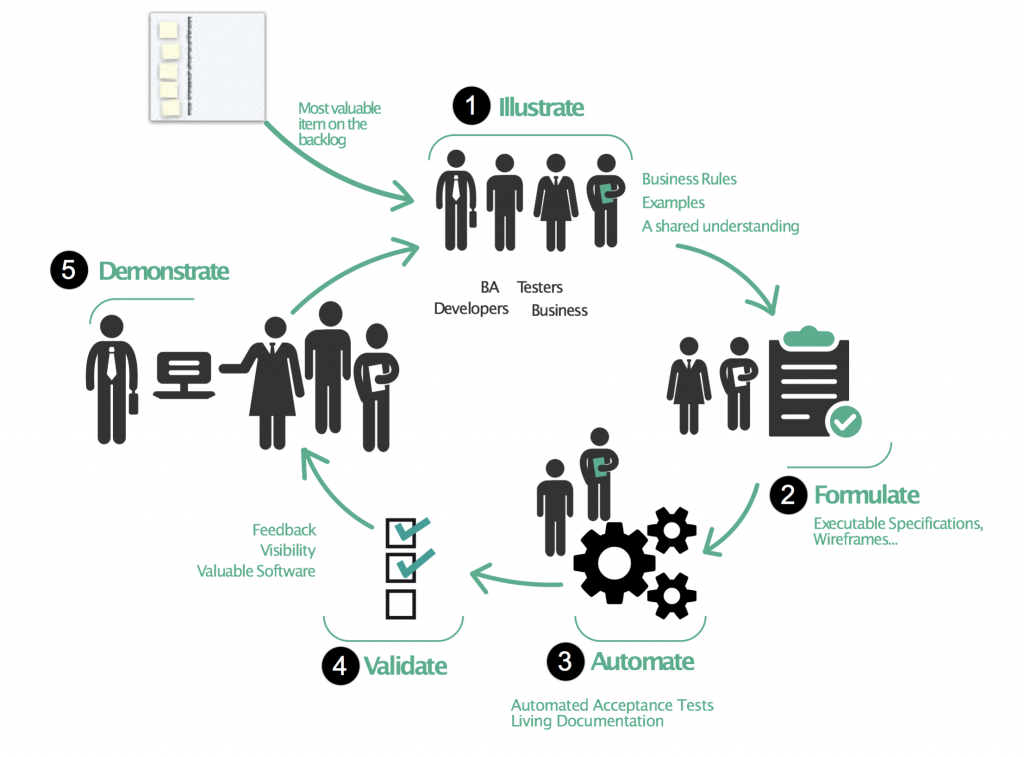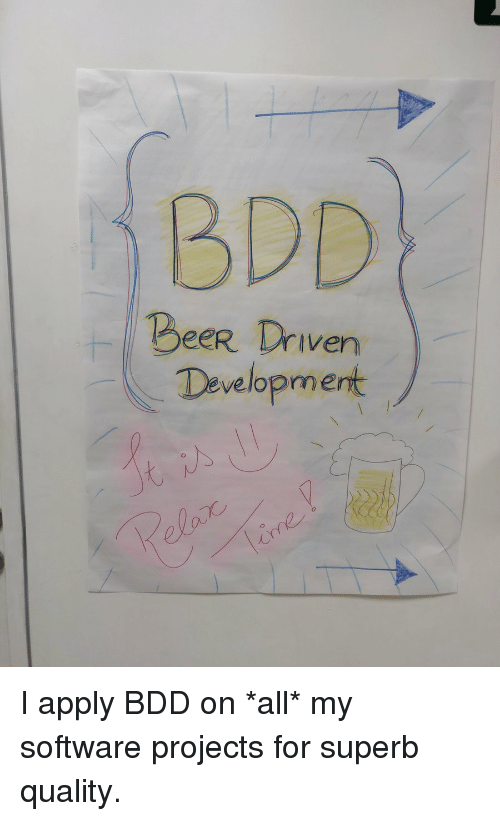What is Behavior Driven Development (BDD)?
In software development, BDD refers to Behavior Driven Development, it is a software development approach. It is an Agile programming development procedure that supports joint effort among designers, QA and non-developers or marketing members in a product . It is written in shared languages and improves the communication between technical and non-technical teams.
It permits the tester/market analyst to develop test cases in easy text language like English. The easy language utilized in the situations helps even non-technical colleagues to comprehend what is happening in the software project.
The BDD focuses on business value which customers get from the software. It also saves the time for the developer to develop the program.
BDD is a process of requirement, gathering and analysis.
BDD improves the communication cause everyone know how the system should behave.
By improving the communication inside the team, we improve quality of the core, and by improving quality, you are basically reducing the costs of maintenance and minimizing the project’s risks.
So in BDD world we are trying to connect Business world to Tech World.
Using BDD in your project
The idea is to write tests in a way that anyone, from business analysts to engineers, can understand. These tests are typically structured using Gherkin syntax, which uses keywords like Given, When, and Then to describe the behavior of a feature.
The steps to implement BDD in your software are as follows:
1. Identify User Stories: You have to work with stakeholders to identify user stories that describe the desired features.
2. Define Scenarios: Break down each user story into scenarios and then write each scenario in the Given-When-Then format on feature files.
3. Automate Tests: Use a BDD framework to automate the scenarios. Frameworks like Cucumber (for various languages), SpecFlow (for .NET), and Behave (for Python) are commonly used.
4. Write the Code: Implement the code necessary to pass the automated tests.
5. Run and Refactor: Run the tests to ensure they pass. Refactor the code as needed to maintain quality and readability.
Example of a Feature File
Feature: Calculator
Simple calculator for adding **two** numbers
@Add
Scenario: Add two numbers
Given the first number is 50
And the second number is 70
When the two numbers are added
Then the result should be 120Behind the scenes each sentence of this feature file, translated to a setup/action/assertion of a test ( e.g API, Integration, E2E) that runs on a CI pipeline.
//Example in C# and SpecFlow
using System.Threading.Tasks;
using FluentAssertions;
using SpecFlowCalculator.Specs.API;
using TechTalk.SpecFlow;
namespace SpecFlowCalculator.Specs.Steps
{
[Binding]
public sealed class CalculatorStepDefinitions
{
private readonly CalculatorApi _calculator;
private int _result;
public CalculatorStepDefinitions(CalculatorApi calculator)
{
_calculator = calculator;
}
[Given("the first number is (.*)")]
public void GivenTheFirstNumberIs(int number)
{
_calculator.FirstNumber = number;
}
[Given("the second number is (.*)")]
public void GivenTheSecondNumberIs(int number)
{
_calculator.SecondNumber = number;
}
[When("the two numbers are added")]
public async Task WhenTheTwoNumbersAreAddedAsync()
{
_result = await _calculator.AddAsync();
}
[Then("the result should be (.*)")]
public void ThenTheResultShouldBe(int result)
{
_result.Should().Be(result);
}
}
}So there is a Calculator API that adds 2 numbers. Business people know nothing how the tests works, they only know feature files and that tests run and ensure the business cases. Developers & Testers understand fully the expected behavior and write the test to add it to the pipeline.
Here is a high overview of the whole process:

Pros of Behavior Driven Development (BDD)
- The BDD uncovers additional capabilities and complexities from the project. As it identified the scenarios in the start so there is less rework at the end of the project.
- It is the domain specific language that focuses on the domain of your business and it is also important for defining the project specifications. It avoids misunderstandings and improves the communication.
- As the details specifications are written in the starting and we write tests before the code. So this is the plus point for the BDD as the developers only need to focus on implementing which makes the test cases pass. So the developers do not focus on other features
- The involvement of the tester starts from the starting of the project life cycle, specification phase. Testing is a backout task and it only comes to play when there is a physical product to test. Testers have the analytical talent and can start from the starting of the project.
- The product Owner has knowledge of what we need to deliver as a piece of functionality. The pieces of functionality are broken down into pieces that are much more easy to use. This makes the development of the project much easier and removes the complexity of the project in the earlier stages.
- “Shift left” is a popular expression for testing early in the development procedure. Testing prior means less bugs later. In BDD, test case definition inherently turns out to be a piece of the necessities stage (for waterfall) or prepping (for Agile). When conduct situations are composed, testing and automation can theoretically start.
Cons of Behavior Driven Development (BDD)
- Creating the Scenarios and maintaining the files needs lots of effort and time. So it is not good for a short project which we need to complete in a short interval of time. But for a long term project it’s worth using the BDD approach.
- We need good communication between the person who is developing the automation code and the person who is writing the features files. Person who is writing the automation needs these files and scenarios for developing the automation script. If they Don’t have a mutual understanding of the files then it’s hard to develop the project.
- It defines test data which makes it easier to create automated test cases but when used to execute test cases it raises the problem when the test environment is never left in a known state. The test cases are dependent on the external data often causing the problem when we execute the test cases
- It is very hard to convert Given statements into setup instructions and scripts that puts the system into the known state before the When statements are executed.
- You need to create the document for the BDD project because there are many files and scenarios which need to be understood so that we create a documentation.
- The main drawbacks of BDD are two-fold. Since correspondences between the client and the developer are basic, if the client is not available, it will be hard to work past ambiguities and questions created by the client stories.
Where is the Beer?
The beer comes when you have to deal with 2 different worlds. You have to drink a lot of beers to relax and understand how this connection can work without making breaking changes.
Behavior Driven Development is all about connecting business goals with technical execution, but sometimes it’s easy to get bogged down in the details. That’s where Beer Driven Development comes in. It’s not just a methodology—it’s a mindset. By bringing a sense of fun and relaxation to the process, we can bridge the gap between business and tech in a way that’s not only effective but also enjoyable.
So, next time you’re stuck on a problem or struggling to get everyone on the same page, remember: sometimes all you need is a cold beer to drive development forward.
Cheers to better communication, better collaboration, and better code—one beer at a time! 🍻

